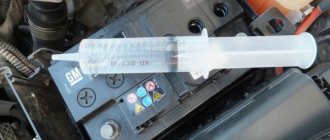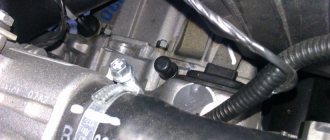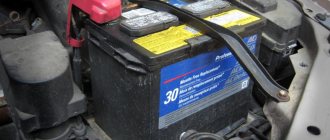Winter has an extremely negative impact on the condition of the car. And the batteries that suffer the most are the load on which is much higher in winter than in summer. The reason is the increase in electricity consumption.
Battery care can be divided into two components:
- Ensuring battery performance during continuous use;
- Creation of appropriate storage conditions during the “wintering” of the car in the garage.
Winter battery operation
A car that has been sitting in the cold for a long time often does not want to start the first time. And even when starting, an engine with frozen pistons and cylinders requires significantly more output from the battery than when starting conditions were not so extreme. As a result, the battery can hardly be charged. Therefore, the car owner will have to constantly maintain it in working condition, paying more attention to it.
And you should remember this not with the onset of frost, but much earlier. The reason is that if the engine is cranked for a long time (more than 15 minutes), this will cause the battery plates to melt, its energy capacity will drop, and its performance will deteriorate. To keep your battery in working condition in winter, you should do the following:
- Clean the battery case and ventilation holes from any dirt that has accumulated there over the summer;
- The oxide should be removed from the terminals and treated with lithol;
- There is no need to tighten the bolts during processing, so that if such a need arises (in the form of a short circuit), the terminals can easily open;
- Increase the charge level of the battery power supply to the standard specified by the manufacturer. If, due to the lack of special equipment or relevant experience, it is impossible to do this yourself, you should use the help of professionals.
These steps should be performed at least twice a month, and preferably more often (especially if the battery is old and barely working). If possible, it is best to leave the battery “overnight” in the house. We must not forget that the speed of all processes occurring in the battery slows down as the temperature decreases, which results in its energy intensity decreasing.
Additionally, it should be noted that in order to ensure uninterrupted operation of the battery in winter, it is necessary to use one or another thermal insulation material, thereby protecting the battery and engine compartment from frost. At the same time, throughout the winter you should increase the performance of the battery by recharging it from time to time.
In our climate, it wouldn’t hurt to buy special starter batteries that operate on lead plates. This would indeed be a wise decision, since such batteries work well even when the temperature drops well below zero.
How to store a battery in winter
How the battery will be stored is of enormous importance. In this case, it is advisable to disconnect the battery by disconnecting one terminal. In this case, the battery will discharge slightly, after which it will no longer need regular recharging. If the temperature outside is very low, then it is best to remove the battery from the car and put it in the warmest possible place. Such a place could be a basement or cellar, where the temperature is noticeably higher than outside.
You need to understand that the principles of battery storage largely depend on the state in which it is - whether it is filled with electrolyte or whether it is “dry”. For a dry-charged battery, the storage room should not be damp and should have good ventilation.
Before storing the battery, you should check how tight all the plugs on the banks are. In addition, there should be no damage to the battery case.
Current charge value and battery maintenance
The current value of the first and subsequent battery charges is usually maintained by adjusting the charger. The duration of the first charge depends on the duration and storage conditions of the battery. Until the electrolyte is filled in and can reach 25-50 hours. Charging continues until significant gas generation occurs in all batteries. And the density and voltage of the electrolyte become constant for 3 hours, which serves as a sign of the end of charging. To reduce corrosion of the positive plates, the charging current at the end of the charge can be halved. Discharge the battery by connecting a wire or plate rheostat to the battery terminals using an ammeter. At the same time, its setting is maintained by a discharge current value equal to 0.05 of the rated battery charge in Ah.
How to store a battery with electrolyte
In order for the battery to meet spring while maintaining working condition, you need to sequentially disconnect the terminal. First with a minus, and then with a plus. The fact that the terminals must be disconnected in this way is very important, since otherwise a short circuit may occur that can damage the equipment. Batteries should only be stored horizontally. This rule applies to all types of batteries, not just flooded ones. To prevent the battery from breaking, you do not need to drain the electrolyte from it.
Before the battery is stored, the electrolyte must be removed from its case. After this, you need to check the level of electrolyte in the banks. If it turns out to be low, you should add distilled water to normal. Do not use ordinary tap water or acid during operation as this may damage the battery. Just before the battery is sent for storage, it should be charged to maximum.
Maintenance of a dry charged battery
Because the active mass of the plates on a dry-charged battery contains up to 20% or more of lead sulfate, which during charging turns into spongy lead, lead dioxide and sulfuric acid. The amount of distilled water and sulfuric acid required to prepare 1 liter of electrolyte depends on its density. To prepare the required volume of electrolyte. For example, for a 6ST-75 battery, into which 5 liters of electrolyte with a density of 1270 kg/m3 is poured, the values at a density equal to 1270 kg/m3 are multiplied by five, poured into a clean porcelain, hard rubber or glass reservoir with 0.778. -5 = 3.89 liters of distilled water. And while stirring, pour in 0.269-5 = 1.345 liters of sulfuric acid in small portions. It is strictly forbidden to pour water into the acid, as this will cause the water stream to boil and release vapors and drops of sulfuric acid.











